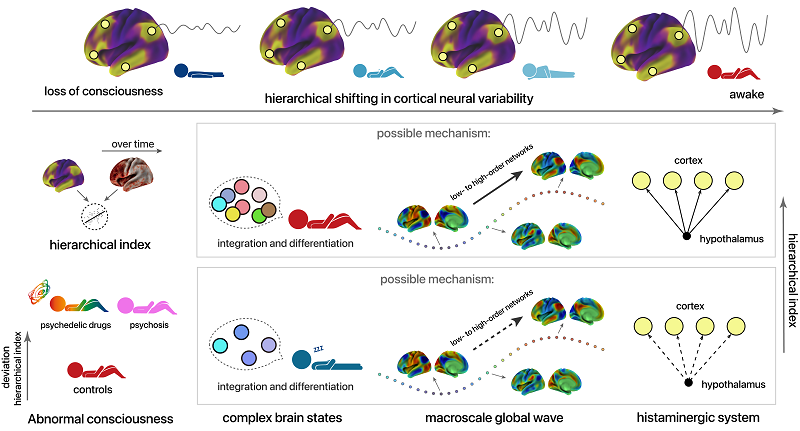Chinese scientists discovered a simple neural signature for the state of consciousness from complex spontaneous brain activities
On June 5, the research groups of LI Ang and WANG Xiaoqun from the Institute of Biophysics, Chinese Academy of Sciences, published an article in the international journal Nature Communications. This study unveiled an interesting discovery: a simple neural signature for determining the state of consciousness based on complex spontaneous brain activities. They validated this signature across different experimental paradigms, imaging modalities, and species.
Where does consciousness lie? This is one of 125 unsolved scientific mysteries listed by Science. The brain, as a complex and dynamic system, guides our diverse subjective experiences through fluctuations in its global level of consciousness on temporal scales. Whether there is a simple pattern corresponding to the complex changes in brain activity in different states of consciousness remains to be explored.
The research groups of LI Ang and WANG Xiaoqun integrated multimodal cross-scale data to develop a computational modelling framework for global states of consciousness. They analyzed the functional MRI data under different states of consciousness, including anesthesia, sleep, resting, drowsiness, mental illnesses, and psychedelics. They revealed that the global state of consciousness might depend not on a single isolated brain region but on hierarchical dynamic patterns in topological space. They introduced the concept of "constrained brain spaciotemporal nesting feature" as a simple neural signature to determine the state of consciousness.
The findings presented in this study lend support to classical theories of consciousness from multiple perspectives and contribute to the development of a new and comprehensive model explaining the states of consciousness. Additionally, the research team conducted an analysis of electrocorticography data from two extensively sampled macaques, exploring their different states of consciousness, including sleep and anesthesia. These analyses successfully replicated the core experimental results, further bolstering the study's conclusions.

Figure: A brain spaciotemporal nesting pattern of neural variability and hierarchical topology as the neural signature for the state of consciousness
In addition, the study raises new questions. For example, how do the complex dynamics of high-order brain regions support human waking behaviors? How can individualized prediction models be optimized to mitigate the potential effects of different states of consciousness? The research groups are currently working on new studies to answer these questions.
This study was supported by the Ministry of Science and Technology, the Chinese Academy of Sciences, and the National Natural Science Foundation of China.
Article link:
https://www.nature.com/articles/s41467-023-38972-x
Contact: LI Ang
Institute of Biophysics, Chinese Academy of Sciences
Beijing 100101, China
Email: al@ibp.ac.cn
(Reported by Prof. LI Ang's group)

